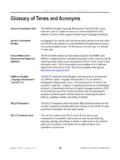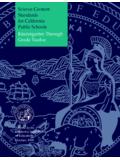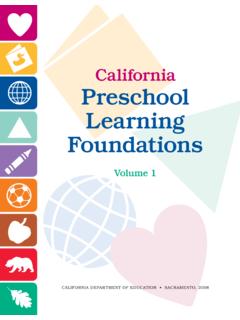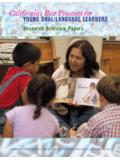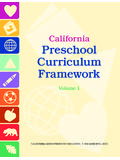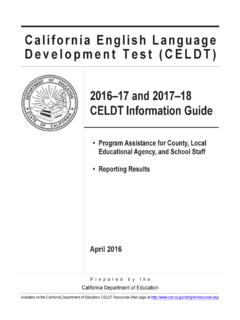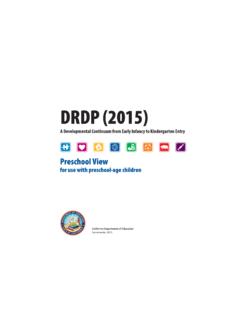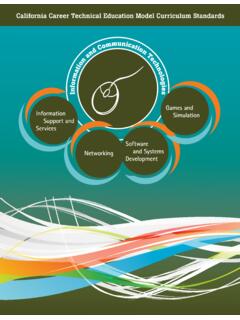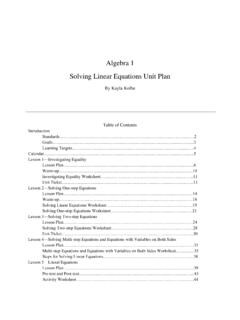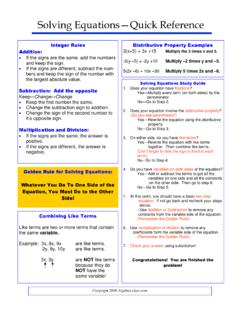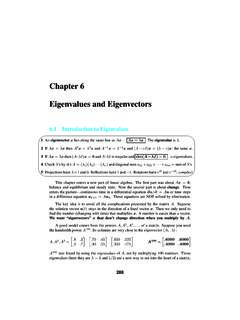Transcription of Algebra I Chapter - California Department of Education
1 Algebra I Chapter of theMathematics Framework for California Public Schools:Kindergarten Through Grade TwelveAdopted by the California State Board of Education , November 2013 Published by the California Department of EducationSacramento, 2015 Algebra IAlgebra IThe main purpose of Algebra I is to develop students fluency with linear, quadratic, and exponential functions. The critical areas of instruction involve deepening and extending students understanding of linear and exponential relationships by comparing and contrastingthose relationships and by applying linear models to data that exhibit a linear trend. In addition, students engage in methods for analyzing, solving , and using exponential and quadratic functions. Some of the overarching elements of the Algebra I course include the notion of function, solving equations, rates of change and growth patterns, graphs as representations of functions, and modeling.
2 Algebra IIGeometryFor the Traditional Pathway, the standards in the Algebra I course come from the following conceptual categories: Modeling, Functions, Number and Quantity, Algebra , and Statistics and Probability. The course content is explained below according to these conceptual categories, but teachers and administrators alike should note that the standards are not listed here in the order in which they should be taught. Moreover, the standards are not simply topics to be checked off from a list during isolated units of instruction; rather, they represent content that should be present throughout the school year in rich instructional experiences. California Mathematics Framework Algebra I 409 What Students Learn in Algebra IIn Algebra I, students use reasoning about structure to define and make sense of rational exponents and explore the algebraic structure of the rational and real number systems.
3 They understand that numbers in real-world applications often have units attached to them that is, the numbers are considered quantities. Students work with numbers and operations throughout elementary and middle school has led them to an understanding of the structure of the number system; in Algebra I, students explore the structure of algebraic expressions and polynomials. They see that certain properties must persist when they work with expressions that are meant to represent numbers which they now write in an abstract form involving variables. When two expressions with overlapping domains are set as equal to each other, resulting in an equation, there is an implied solution set (be it empty or non-empty), and students not only refine their techniques for solving equations and finding the solution set, but they can clearly explain the algebraic steps they used to do began their exploration of linear equations in middle school, first by connecting proportional equations (, ) to graphs, tables, and real-world contexts, and then moving toward an under-standing of general linear equations (y=mx+b, m 0) and their graphs.
4 In Algebra I, students extend this knowledge to work with absolute value equations, linear inequalities, and systems of linear equa-tions. After learning a more precise definition of function in this course, students examine this new idea in the familiar context of linear equations for example, by seeing the solution of a linear equation as solving for two linear functions and .Students continue to build their understanding of functions beyond linear ones by investigating tables, graphs, and equations that build on previous understandings of numbers and expressions. They make connections between different representations of the same function. They also learn to build functions in a modeling context and solve problems related to the resulting functions. Note that in Algebra I the focus is on linear, simple exponential, and quadratic , students extend their prior experiences with data, using more formal means of assessing how a model fits data.
5 Students use regression techniques to describe approximately linear relationships be-tween quantities. They use graphical representations and knowledge of the context to make judgments about the appropriateness of linear models. With linear models, students look at residuals to analyze the goodness of of Key Advances from Kindergarten Through Grade Eight Having already extended arithmetic from whole numbers to fractions (grades four through six) and from fractions to rational numbers (grade seven), students in grade eight encountered specific irrational numbers such as 5and . In Algebra I, students begin to understand the real number system. (For more on the extension of number systems, refer to NGA/CCSSO 2010c.) Students in middle grades worked with measurement units, including units obtained by multiplying and dividing quantities.
6 In Algebra I (conceptual category N-Q), students apply these skills in a more sophisticated fashion to solve problems in which reasoning about units adds insight. 410 Algebra I California Mathematics Framework Algebraic themes beginning in middle school continue and deepen during high school. As early as grades six and seven, students began to use the properties of operations to generate equivalent expressions (standards and ). By grade seven, they began to recognize that rewriting expressions in different forms could be useful in problem solving (standard ). In Algebra I, these aspects of Algebra carry forward as students continue to use properties of operations to rewrite expressions, gaining fluency and engaging in what has been called mindful manipulation. Students in grade eight extended their prior understanding of proportional relationships to begin working with functions, with an emphasis on linear functions.
7 In Algebra I, students master linear and quadratic functions. Students encounter other kinds of functions to ensure that general prin-ciples of working with functions are perceived as applying to all functions, as well as to enrich the range of quantitative relationships considered in problems. Students in grade eight connected their knowledge about proportional relationships, lines, and linear equations (standards 6). In Algebra I, students solidify their understanding of the analytic geometry of lines. They understand that in the Cartesian coordinate plane: the graph of any linear equation in two variables is a line; any line is the graph of a linear equation in two variables. As students acquire mathematical tools from their study of Algebra and functions, they apply these tools in statistical contexts ( , standard ).
8 In a modeling context, they might informally fit a quadratic function to a set of data, graphing the data and the model function on the same coordinate axes. They also draw on skills first learned in middle school to apply basic statistics and simple probability in a modeling context. For example, they might estimate a measure of center or variation and use it as an input for a rough calculation. Algebra I techniques open an extensive variety of solvable word problems that were previously inaccessible or very complex for students in kindergarten through grade eight. This expands problem solving Mathematical Practices and ContentThe Standards for Mathematical Practice (MP) apply throughout each course and, together with the Standards for Mathematical Content, prescribe that students experience mathematics as a coherent, relevant, and meaningful subject.
9 The Standards for Mathematical Practice represent a picture of what it looks like for students to do mathematics and, to the extent possible, content instruction should include attention to appropriate practice standards. There are ample opportunities for students to engage in each mathematical practice in Algebra I; table A1-1 offers some general examples. California Mathematics Framework Algebra I 411 Table A1-1. Standards for Mathematical Practice Explanation and Examples for Algebra IStandards for Mathematical Explanation and ExamplesPracticeM learn that patience is often required to fully understand what a problem is asking. They discern between useful and extraneous Make sense of problems and perse-information. They expand their repertoire of expressions and functions vere in solving can be used to solve problems. M P. 2 Students extend their understanding of slope as the rate of change of a linear function to comprehend that the average rate of change of any Reason abstractly and can be computed over an appropriate P.
10 3 Students reason through the solving of equations, recognizing that solving an equation involves more than simply following rote rules and Construct viable arguments and steps. They use language such as If , then when critique the reasoning of others. explaining their solution methods and provide justification for their Students build proofs by induction proofs by contradiction. CA (for higher mathematics only).M P. 4 Students also discover mathematics through experimentation and by examining data patterns from real-world contexts. Students apply their Model with mathematical understanding of exponential, linear, and quadratic functions to real-world P. 5 Students develop a general understanding of the graph of an equation or function as a representation of that object, and they use tools such Use appropriate tools graphing calculators or graphing software to create graphs in more complex examples, understanding how to interpret results.

